A Complete Organic Approach To Growing.
The Growing Environment
Growing Greenhouse
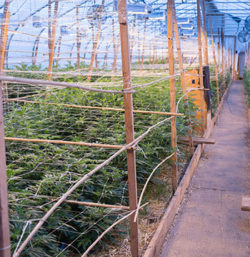 Our favorite growing environment at sofresh farms is the greenhouse. We have a couple of greenhouses that we use to cultivate vegative and flowering plants. The light assist, light deprivation greenhouse produces the highest quality flowers available on the market while using less energy than the indoor room. There is something magical about the sun that plants prefer over only HPS or LED lights. Full spectrum photobiology plays an important part in the plants development and we see plants that have the benefit of the sun and consistent HPS light when the sun doesn’t shine consistently produce the highest quality flowers at sofresh farm. We have plans to decommission our indoor growing environments in favor of the quality we can produce in temperature, humidity and light controlled greenhouses.
Our favorite growing environment at sofresh farms is the greenhouse. We have a couple of greenhouses that we use to cultivate vegative and flowering plants. The light assist, light deprivation greenhouse produces the highest quality flowers available on the market while using less energy than the indoor room. There is something magical about the sun that plants prefer over only HPS or LED lights. Full spectrum photobiology plays an important part in the plants development and we see plants that have the benefit of the sun and consistent HPS light when the sun doesn’t shine consistently produce the highest quality flowers at sofresh farm. We have plans to decommission our indoor growing environments in favor of the quality we can produce in temperature, humidity and light controlled greenhouses.
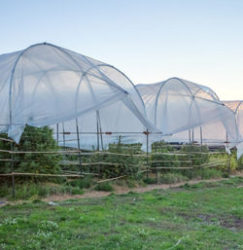 Growing sun only
Growing sun only
sofresh farms also grows premium sun-grown flower that ripens under the September and October sun (weather permitting) and is usually available in the winter and early spring. The long Oregon summer days grow big plants and create dense, potent flowers known for their vibrant dark colors, rich smell and intense flavors. To help protect sofresh’s sun grown cannabis from the mold creating and terpene robbing rain and dew that is often present in the Pacific NW in the fall, we take the time to carefully thin and train our plants before building hoop houses over the flower for the last 4 to 6 weeks of ripening.
Living Soil
sofresh farms raised beds stand about two feet high on native soil and are composed of a mixture of peat moss, pearlite/bio-char, worm castings and compost as well as small amounts of other balanced nutrients. The goal is to create a synergy between the plants and the soil. We believe in a “living soil” by creating an environment that is perfect for both beneficial life and cannabis. We start by inoculating the plants with mycorrhizae in the vegetative stage and continue through the beginning of flower. We use a combination of different organic methods to feed our plants. Among them, we brew our own teas and feed it to the soil where the beneficial bacteria break it down and make food for the plants. This makes the beneficial microbes very happy and they respond by breaking down the nutrients the plants need to flourish.
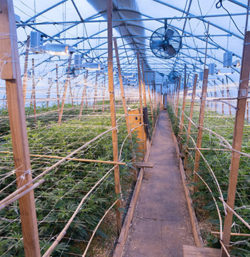 Room to Breathe
Room to Breathe
One of the worst things that can happen to living soil raised flower beds is having the soil compacted so flat that all the tiny little air spaces are destroyed which will create anaerobic conditions that don’t support plant life. Those little air spaces may not seem very important but they are. Good healthy soil structure allows a place for roots to grow and absorb carbon and oxygen while cycling nutrients in the symbiotic relationships the roots create with their neighbors. Oxygen also allows a place for water to flow like little microscopic streams. If you’ve ever hiked a well-worn dirt trail you understand how soil can be compacted by people walking on it. That’s why at sofresh we chose to build wood walkways above the flower beds making it unnecessary to step on the beds when working with the plants—when we are in the plants home we don’t step on their feet. This keeps the soil fluffier than grandma’s pancakes!
Wet Feet
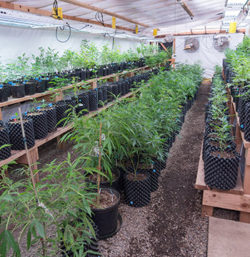 Have you ever been out walking in the rain and end up with wet feet? You take off your shoes and your feet look like a couple of big raisins? Trust me on this, plants don’t like it any better than you do. That’s why keeping the soil in perfect moisture balance is a must at sofresh farms. We use several different techniques to balance moisture levels in our living soil but nothing beats close observation and hand testing. It’s not hard to hold up a clump of soil and figure out if it’s too wet or not. We use drip irrigation to slowly deliver precise amounts of water to the area its needed without creating any runoff. After big rain events in the winter we struggle with our beds on native soil and high water table to keep our plant roots from oversaturating with water so we will compensate with less irrigation. If the soil sticks together, drips and won’t easily break apart, it’s too wet. If the soil won’t make a ball and hold its shape, it’s too dry.
Have you ever been out walking in the rain and end up with wet feet? You take off your shoes and your feet look like a couple of big raisins? Trust me on this, plants don’t like it any better than you do. That’s why keeping the soil in perfect moisture balance is a must at sofresh farms. We use several different techniques to balance moisture levels in our living soil but nothing beats close observation and hand testing. It’s not hard to hold up a clump of soil and figure out if it’s too wet or not. We use drip irrigation to slowly deliver precise amounts of water to the area its needed without creating any runoff. After big rain events in the winter we struggle with our beds on native soil and high water table to keep our plant roots from oversaturating with water so we will compensate with less irrigation. If the soil sticks together, drips and won’t easily break apart, it’s too wet. If the soil won’t make a ball and hold its shape, it’s too dry.
Irrigation
Rain, well and waste water combine to fill sofresh’s irrigation systems. Rain is captured from the structures and stored in large tanks before being pumped into the drip irrigation systems. Purified waste water from AC and dehumidification is captured and used for foliar feeding, compost-tea, IPM and irrigation. Citric Acid is used to PH water down when needed.
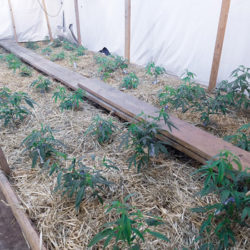 The Neighborhood
The Neighborhood
sofresh farms also believe there are benefits to growing plants together in the same bed. They can share beneficial microbes, worms and basically talk to one another. Think of the beds like your own neighborhood. Everyone likes friendly neighbors! We also feel that roots need room to grow. We accomplish this by preparing the sub-soil with a broad fork 18” deep, below the raised-beds. This allows the plant’s roots to spread out freely with no walls inhibiting their growth.
Nutrients
Plants need to eat just like you and me. Whether you feed plants synthetic or organic nutrients the goal is usually the same, quality product. At sofresh farms we believe that an organic approach is best for both plants and you. So not only do we hunt down the finest organic ingredients available we also make our own.
Applying the law of return by taking a page from the Korean Natural Farming playbook, we take the leaves and stems from the thinning and trimming process and put them into a large containers with water. We then add water and a lactic acid bacteria to the mix and let it ferment, stirring occasionally for a couple weeks, depending on temperature. When the mix starts to smell sweet we will airate the mix and let the alcohol to evaporate. What’s left is a perfect blend of many of the nutrients that were removed during the growth of the plant. For the flower stage, we add a little more stem and veg likes more leaves. This blend along with the minerally balanced soil make for beautiful and healthy plants.
The Finish Line
Harvest Time
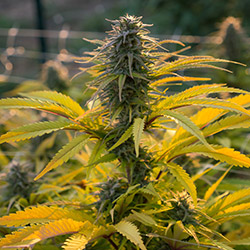 Most sofresh genetics take 8 to 10 weeks to flower. When the harvest is near we start watching the plants carefully. We look for the trichome heads to be mostly cloudy with some clear and a few beginning to turn amber. We like to wait until the flower reaches this stage of maturity to achieve the highest cannabinoid and terpene content. Wait too long or harvest too early and the profiles will change making the plant less potent and have a racier effect if harvested early or sleepy if harvested late. Harvest time is dependent on the strain and environmental conditions so over the course of a few weeks, flowers from a specific growing environment will be carefully cut and hung upside down without touching the flower or damaging the trichome. Then comes the fun part.
Most sofresh genetics take 8 to 10 weeks to flower. When the harvest is near we start watching the plants carefully. We look for the trichome heads to be mostly cloudy with some clear and a few beginning to turn amber. We like to wait until the flower reaches this stage of maturity to achieve the highest cannabinoid and terpene content. Wait too long or harvest too early and the profiles will change making the plant less potent and have a racier effect if harvested early or sleepy if harvested late. Harvest time is dependent on the strain and environmental conditions so over the course of a few weeks, flowers from a specific growing environment will be carefully cut and hung upside down without touching the flower or damaging the trichome. Then comes the fun part.
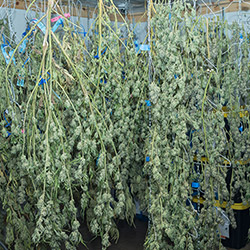 Drying and Processing
Drying and Processing
sofresh has several drying rooms set up to cure the flower low and slow. We start the flowers out at around 40% humidity for a first couple days then raise it to 50%-55% RH with the goal of hitting the perfect level of just below 60% humidity. Anything above this level of moisture in the air adds to the flower and anything below causes it to dry out. Temperature stays in the mid to low 60’s for drying and storage. Once the leaf stems have dried to the point of being brittle we slow the drying process even further by taking the flowers off of their hangers and putting them into large storage totes that are occasionally burped while being kept cool and dark so that the remaining water in the flower can slowly escape while perfectly preserving the cannabinoids and terpenes.
Trimming
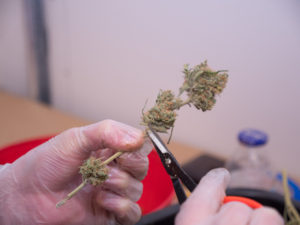 When the buds reach the perfect dryness, they are hand trimmed by some of the best in the world. All the workers handle the buds like they are holding a humming bird by the feet. They avoid touching the buds with their hands and only use the tips of the scissors to trim with. Every leaf, kick-stand and crow’s foot is clipped with only frosty goodness left behind. Every bud is trimmed to the perfect size, not too big and not to small…they’re just right. All of the prize winning flowers are separated by quality and size, small flowers are used to roll soCones and all of the leaf and trim is used to make purified cannabinoid and terpene extracts. The best flowers are separated and carefully stored while they wait for their test results and glass jar.
When the buds reach the perfect dryness, they are hand trimmed by some of the best in the world. All the workers handle the buds like they are holding a humming bird by the feet. They avoid touching the buds with their hands and only use the tips of the scissors to trim with. Every leaf, kick-stand and crow’s foot is clipped with only frosty goodness left behind. Every bud is trimmed to the perfect size, not too big and not to small…they’re just right. All of the prize winning flowers are separated by quality and size, small flowers are used to roll soCones and all of the leaf and trim is used to make purified cannabinoid and terpene extracts. The best flowers are separated and carefully stored while they wait for their test results and glass jar.
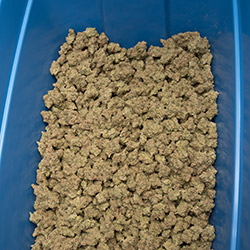 Hanging Out
Hanging Out
After the flowers are trimmed we place them one last time in large totes to cure for a few weeks to a couple of months depending on the strain. The totes aren’t air-tight so the buds can breathe and slowly cure to perfection. A little cure time can make a huge difference. During this time sofresh has every batch tested by a third-party lab for the state mandated potency, water content and pesticide tests. After the large curing bins, the top shelf buds find themselves in large gallon jars with sofresh labels, genetics information and batch specific THC and CBD potency information. Using glass jars lets us sanitize and re-use the wholesale packaging instead of creating more plastic bag waste.
Storage & Packaging
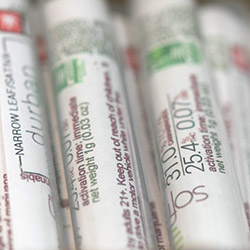 sofresh farms believes the moisture content of flower is very important. We go to great lengths to make sure our flower is stored in the perfect environment for curing. The temperature and humidity is constantly monitored and kept close to 60 degrees and 60% RH to ensure the flower retains all the original smell and flavor. All our flowers are carefully packaged in sealed glass jars to ensure they arrive in the best possible condition. The jars are also environmental friendly as they can be washed and used many times. We know every time a bud is handled some of the tiny trichomes are broken off. That’s why we keep all contact to a minimum and only handle the flowers by their stems.
sofresh farms believes the moisture content of flower is very important. We go to great lengths to make sure our flower is stored in the perfect environment for curing. The temperature and humidity is constantly monitored and kept close to 60 degrees and 60% RH to ensure the flower retains all the original smell and flavor. All our flowers are carefully packaged in sealed glass jars to ensure they arrive in the best possible condition. The jars are also environmental friendly as they can be washed and used many times. We know every time a bud is handled some of the tiny trichomes are broken off. That’s why we keep all contact to a minimum and only handle the flowers by their stems.
IPM Integrated Pest Management
sofresh farms takes organic pest control to a whole new level. It’s called Integrated Pest Management or IPM for short. IPM is a combination of proven pest control management techniques that use different organic methods to ensure our product is residue and containment free.
Plant Positive
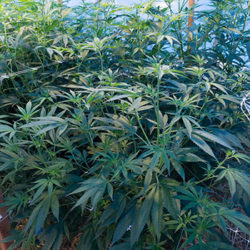 The first step to establishing a good IPM program starts with growing healthy plants. Pests are naturally attracted to unhealthy, unbalanced plants, in nature insects help the plant cycle nutrients by decaying old plant waste and turning it into food for the next cycle. At sofresh we always start our plant positive approach by creating a healthy, PH and nutrient balanced soil full of beneficial microbiology and fungi. If even one of the 17 macro/micro nutrients are out of balance or if there are extreme changes in soil moisture or oxygen levels your biology is likely to suffer and plants will become stressed. Managing temperature, light and humidity to maintain an ideal climate that is just right for the plants lifecycle also plays a key role in creating a healthy, plant-positive, growing environment that is pest free.
The first step to establishing a good IPM program starts with growing healthy plants. Pests are naturally attracted to unhealthy, unbalanced plants, in nature insects help the plant cycle nutrients by decaying old plant waste and turning it into food for the next cycle. At sofresh we always start our plant positive approach by creating a healthy, PH and nutrient balanced soil full of beneficial microbiology and fungi. If even one of the 17 macro/micro nutrients are out of balance or if there are extreme changes in soil moisture or oxygen levels your biology is likely to suffer and plants will become stressed. Managing temperature, light and humidity to maintain an ideal climate that is just right for the plants lifecycle also plays a key role in creating a healthy, plant-positive, growing environment that is pest free.
The Cover
Above the rich soil and under the flowering cannabis canopy grows another canopy of smaller plants, including low growing grasses and various types of clover. The purpose of the cover crop plants and the organic compressed straw mulch is to help provide an environment that is friendly to beneficial insects. Planting beneficial plants is a permaculture technique that helps to create a symbiotic, nutrient cycling relationship with the cannabis plants while also helping to regulate soil moisture and temperature. Beneficial plants are a key part in a plant positive IPM program.
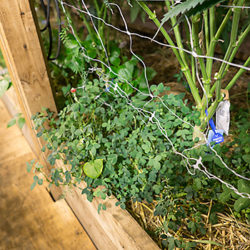 Trap Plants
Trap Plants
Another IPM technique is to use “trap plants”. These types of plants attract the pests we are trying to avoid. Think of a restaurant with only one item on the menu. You can pretty much guess what everyone’s going to order. Now imagine an all you can eat buffet with all kinds of good stuff. Would you go for the day-old broccoli or the cherry cobbler? Trap plants work the same way. Young pole beans to a spider mite are like Krispy Kreme Doughnuts to a stoner. We watch the trap plants closely for any signs of pests and the early warning helps us identify and take care of any issues before the pest pressure gets out of control.
Deterrent Plants
sofresh also grows what we call “deterrent plants” that are planted in high traffic areas to help keep pests away. Plants like rosemary, mint and peppers help to repel problem insects and mites. We look at growing healthy plants, ground cover, trap plants and deterrent plants as the first line of defense, but we also use other methods to keep pests at bay.
Good Bugs
Not every type of bug is bad for your plants. There are many types of predators that eat the bugs, that eat your plants. Most likely you’re familiar with many of the common types of predators such as lady bugs, wasps, beetles and praying mantis but you may not be familiar with the little guys like Stratiolaelaps, Cucumeris, Andersoni, Californicus and Swirskii—a few of sofresh’s army! Why spray your plants with organic soaps and oils that are likely to stress the plant and degrade the finished flower quality when you can hire little predatory bugs that will kill all of the pests for you?
Predatory Fungus, Bacteria and Nematodes
More and more of these very effective biological IPM tools are being developed every year. One thing that we are always sure to be careful to check is how the particular fungus, bacteria or nematode will impact the beneficial insects in the garden. When a pest outbreak goes beyond what can be controlled with plant positive and predatory insect solutions we look to biological warfare as the next tool in our IPM tool box. Depending on the type of biological control we employ, some of these funguses invade the host body then decay them from the inside-out. Then the fungus uses the host’s body to spread the love to all the other pests in the neighborhood. This natural, biological approach to integrated pest management helps eliminate pesticide use and create a healthy environment for everyone, including humans.
Say it Don’t Spray it
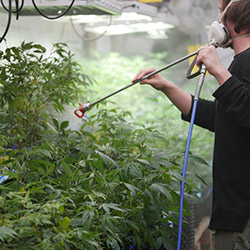 The last form of defense is the use of organic based sprays such as neem oil, soaps, cinnamon oil, lemongrass oil and other types of oils that either suffocate or create a feeding deterrent. Neem oil has been used for centuries and controls virtually every type of pest. A small amount of neem oil is all it takes to make the bugs dine elsewhere.
The last form of defense is the use of organic based sprays such as neem oil, soaps, cinnamon oil, lemongrass oil and other types of oils that either suffocate or create a feeding deterrent. Neem oil has been used for centuries and controls virtually every type of pest. A small amount of neem oil is all it takes to make the bugs dine elsewhere.
Integrated Pest Management is not a simple process but a complex evolving system. It’s a high performing team with all the players working together for the common regenerative cannabis good. sofresh’s IPM doesn’t seek to eliminate bugs in the garden, instead we seek a balanced ecosystem with plants, bugs, nematodes, fungus and bacteria all living in harmony so that when a pest does try to make its home at sofresh there isn’t any room due to all of the beneficial systems in place. No one player receives all the glory because it’s the combination of everyone that makes the whole team win and when it comes to winning, sofresh farms team can’t be beat.
 Clean Green Certified Program
Clean Green Certified Program
The Clean Green Certified program is comprised of three parts: a legal compliance review, a review of the manner in which the product is grown, and a standard agricultural crop inspection. Taken together, the program helps to ensure a grower’s legal compliance as well as distinguishing the quality of the product from others.
Clean Green Certified is a program modeled on the USDA National Organic Program, ensuring environmentally clean and sustainable methods. Clean Green inspects all inputs, from seed or clone selection, soil, nutrients, pesticides, mold treatments, dust control, and source of electricity, to methods of harvesting and processing.
This program reduces the environmental impact of cannabis crops, ensures legality, and regulates what chemicals go into production. A certified operation is licensed to use the Clean Green Certified label on their products after an annual review requiring yearly on-site inspections and third party laboratory testing.
Find out more about clean green certified cannabis crops. http://cleangreencert.com
